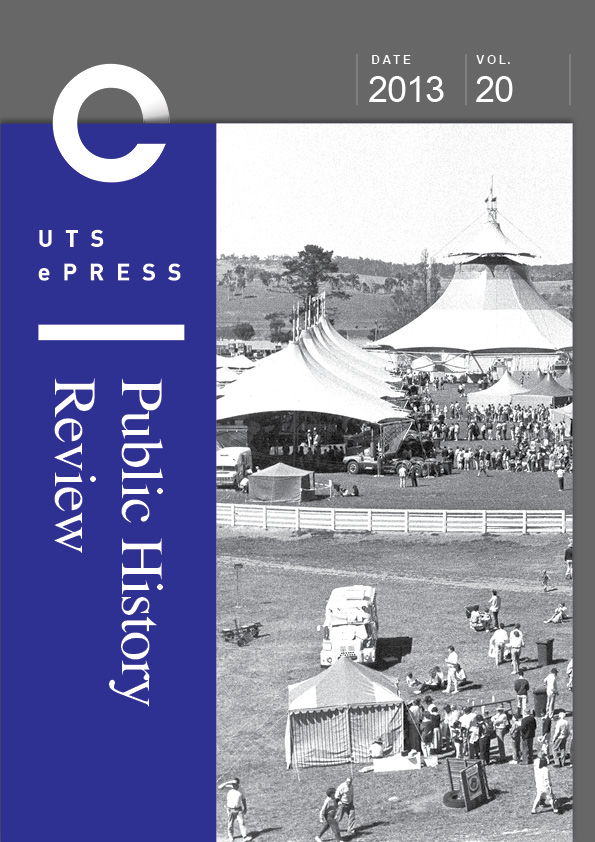Beyond the Walls: Sites of Trauma and Suffering, Forgotten Australians and Institutionalisation via Punitive ‘Welfare’
Main Article Content
Abstract
Article Details
Issue
Section
Authors who submit articles to this journal from 31st March 2014 for publication, agree to the following terms:
a) Authors retain copyright and grant the journal right of first publication with the work simultaneously licensed under a Creative Commons Attribution License that allows others to share and adapt the work with an acknowledgement of the work's authorship and initial publication in this journal.
b) Authors are able to enter into separate, additional contractual arrangements for the non-exclusive distribution of the journal's published version of the work (e.g., post it to an institutional repository or publish it in a book), with an acknowledgement of its initial publication in this journal.
c) Authors are permitted and encouraged to post their work online (e.g., in institutional repositories or on their website) prior to and during the submission process, as it can lead to productive exchanges, as well as earlier and greater citation of published work (See The Open Access Citation Advantage Service). Where authors include such a work in an institutional repository or on their website (ie. a copy of a work which has been published in a UTS ePRESS journal, or a pre-print or post-print version of that work), we request that they include a statement that acknowledges the UTS ePRESS publication including the name of the journal, the volume number and a web-link to the journal item.
d) Authors should be aware that the Creative Commons Attribution (CC-BY) License permits readers to share (copy and redistribute the work in any medium or format) and adapt (remix, transform, and build upon the work) for any purpose, even commercially, provided they also give appropriate credit to the work, provide a link to the license, and indicate if changes were made. They may do these things in any reasonable manner, but not in any way that suggests you or your publisher endorses their use.
For Vol 20 (2013) and before, the following copyright applied:
Authors submitting articles to UTSePress publications agree to assign a limited license to UTSePress if and when the manuscript is accepted for publication. This license allows UTSePress to publish a manuscript in a given issue. Articles published by UTSePress are protected by copyright which is retained by the authors who assert their moral rights. Authors control translation and reproduction rights to their works published by UTSePress. UTSePress publications are copyright and all rights are reserved worldwide. Downloads of specific portions of them are permitted for personal use only, not for commercial use or resale. Permissions to reprint or use any materials should be directed to UTSePress.
References
AUSTRALIAN GOVERNMENT. AUSTRALIAN INSTITUTE OF FAMILY STUDIES. 2002. What is Child Abuse and Neglect [Online]. Available: http://www.aifs.gov.au/cfca/pubs/factsheets/a142091/.
Bacchi, C. 2009. Analysing policy: What's the problem represented to be?, Frenchs Forest, Pearson Education.
Bacchi, C. 2009. Introducing the "What's the Problem Represented to be?" approach. In: Bletsas, A. & Beasley, C. (eds.) Engaging with Carol Bacchi: Strategic Interventions and Exchanges. Adelaide: University of Adelaide Press.
Carrington, K. 1993. Offending Girls: Sex, Youth and Justice, St Leonards, Allen & Unwin.
CARRINGTON, K. 2011. Punitiveness and the Criminalisation of the Other: State Wards, Unlawful Non-citizens and Indigenous Youth. Somatechnics, 1, 33, 40.
FENELEY, R. 2013. They Were Numbers; Now They Have Voices. Sydney Morning Herald [Online]. Available: http://www.smh.com.au/national/they-were-numbers-now-they-have-voices-20131129-2ygzm.html [Accessed 27 December 2013].
FENELY, R. 2013. Kinchela Boys Home: Response to Keith Windschuttle. Sydney Morning Herald [Online]. Available: http://www.smh.com.au/comment/kinchela-boys-home-response-to-keithwindschuttle-20131219-2zmkj.html [Accessed 27 December 2013].
Garfinkel, H. 1956. Conditions of Successful Degradation Ceremonies. American Journal of Sociology, 61, 420-24. https://doi.org/10.1086/221800
HOOKS, B. 2006. Cultural criticism and transformation: part one: On cultural criticism: Why study popular culture? [Online]. Video presentation, Media Education Foundation. Available: http://www.youtube.com/watch?v=zQUuHFKP-9s&feature=related [Accessed 27 September 2012].
PARRAMATTA FEMALE FACTORY PRECINCT ASSOCIATION. 2013. Heritage Information [Online]. Available: http://www.parragirls.org.au/heritage.php [Accessed 15 December 2013].
PARRAMATTA FEMALE FACTORY PRECINCT ASSOCIATION. Parramatta Girls Home: Environment, Routines and Procedures [Online]. Available: http://www.parragirls.org.au/parramatta-girls-home.php [Accessed 14 August 2013].
QUEENSLAND GOVERNMENT. 1999. Forde Inquiry Report: Commission of Inquiry into Abuse of Children in Queensland Institutions [Online]. Available: http://www.communities.qld.gov.au/resources/communityservices/community/forgotten-australians/forde-comminquiry.pdf [Accessed 12 December 2013].
ROUT, M. 2011. Call to include history of children mistreated in care in curriculum. The Australian, 26 September.
SENATE COMMITTEE ON COMMUNITY AFFAIRS 2004. Forgotten Australians: A Report on Australians who Experienced Institutional or Out-of-home Care as Children. Canberra.
Smith, L. 2012. Taking the Children: Children, Childhood and Heritage Making. In: Darien-Smith, K. & Pascoe, C. (eds.) Children, Childhood and Cultural Heritage. Hoboken: Taylor and Francis.
SOUTH AUSTRALIAN GOVERNMENT. 2008. Children in State Care Commission of Inquiry: Allegations of Sexual Abuse and Death from Criminal Conduct [Online]. Available: http://www.sa.gov.au/upload/franchise/Crime,%20justice%20and%20the%20law/Mullighan_Inquiry/CISC%20-%20Introduction.pdf [Accessed 15 December 2013].
UNITED NATIONS. Universal Declaration of Human Rights [Online]. Available: http://www.un.org/en/documents/udhr/ [Accessed 2 August 2013].
Wacquant, L. 2011. The Prison is an Outlaw Institution. The Howard Journal, 51, 6.
Wilson, J. 2008. Prison: Cultural Memory and Dark Tourism, New York, Peter Lang.
Wilson, J. Z., Russell, P. & Mccart, S. 2014. The Parramatta Female Factory Precinct and the National History Curriculum. In: Ashton, P. & Wilson, J. Z. (eds.) Silent System: Forgotten Australians and the Institutionalisation of Women and Children. Melbourne: Australian Scholarly Publishing.
WINDSCHUTTLE, K. 2013. Investigative Journalism, Fairfax-style. Quadrant Online [Online]. Available: https://quadrant.org.au/opinion/bennelongpapers/2013/12/investigative-journalism-fairfax-style/ [Accessed 27 December 2013].
